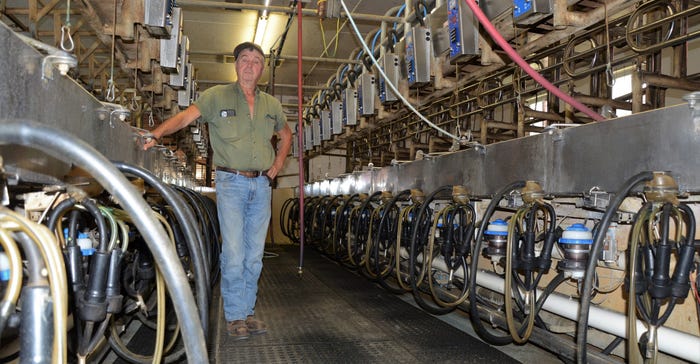
His glassed-over eyes tell a more complicated story than his words. “To be honest, I’m relieved,” says former dairy farmer Hank Choate, after he auctioned off his 485-head Holstein dairy herd in Cement City, Mich.
At age 71, Hank and his brother and business partner, Randy, 66, made the agonizing decision to exit the dairy business rather than continue to look for committed, quality help. “We had an employee leave in 2015, and it took us over four months to find a replacement,” says Hank, who was paying more than $5 above Michigan’s $9.87 minimum wage.
Recently, the farm had a young man leave for another job, and shortly thereafter, Randy’s son was offered an off-farm job for more pay and scheduled hours.
“We recognized it would be a long, tedious process to find new employees with a desire to work on the farm,” Hank says. “We were already putting in 15- to 17-hour days, and the physical demand was one thing, but it was compounded by the mental exhaustion of what to do. In the evening, I’d sit down, have a bite to eat and within 20 minutes my eyes would slam shut, but not for very long. I was maybe getting three-and-a-half hours of sleep because I’d wake up and not be able to get back to sleep.”
The farm has often hired young people looking for employment wanting to learn skills and a work ethic. “But in recent years, we’ve had difficulty finding youth who have an aptitude toward agriculture or any type of work ethic — to show up for work with a desire to learn,” Hank says.
Coming to terms
On a dreary Saturday afternoon, June 26, Randy, Hank and Hank’s son Levi, who works full time on the farm managing the crops, met in the farm shop. It was the kind of meeting where heads hung with serious reflection on the current situation.
The dynamics of the dairy industry have been changing over the past 10 to 15 years, Hank says, but with their efficiencies and production level, “We had a margin that we could live,” he explains.
They had made investments to advance their operation, including adding onto the dairy barn in 2009 and again in 2012. A heifer barn was added in 2014 to open freestall capacity in the dairy barn to almost 500. Manure storage and manure-handling equipment was added, as well as a larger bulk tank.
“Over the last nine years, we’ve invested about $1.3 million into the dairy,” Hank says. “That wasn’t done with the idea of getting out of it. But it really came down to not being able to find labor with a skill set to do the job that I want, which is always focused on the health and well-being of the animals.”
One option was to sell the cows, raise the heifer calves, sell those six to eight weeks before calving and slowly get out of livestock. Already farming 1,800 acres with some cash crops, the focus would then be entirely on cash crops, and the workforce would shrink from 11 to just Hank, Randy and Levi — with no reliance on outside labor.
Another option was to see if they could hold on for a few more months and aggressively search for new employees.
During the summer months, two of Hank’s oldest granddaughters, Allie, 14, and Kaylin, 11, stepped up to complete the calf chores, but summer’s end and school were closing in.
It took five days to mull the idea before the three met again in the shop. “We decided now was the time to say goodbye to the girls,” says Hank, who put a lot of consideration into the well-being of employees both before and after the cows were sold. It was a difficult decision, but for his family, it was the right decision, Hank says, as the exhaustion was starting to become overwhelming.
Randy simply says, “It’s time to do other things — things the cows always took priority over.”
Hank’s daughter Stacey Hughes, who helps on the farm occasionally and runs a seed dealership says, “This land has been in our family since 1837, and we intend to keep it that way. Unfortunately, big and hard decisions need to be made to do so.”
When employees were informed of the impending sale, Hank says, “We’re very fortunate and thankful they all agreed to stay until the cows were gone. And, once the decision was made, one of the first people I spoke to outside of family was the owner of a dairy farm in Jonesville to see what kind of labor they were looking for.” The Hispanic milking crew all found jobs on other dairies, including three in Jonesville.
“I knew none of our employees would have a difficult time finding a job — they are all now employed,” Hank says.
Andrew Reinker, Levi’s brother-in-law, has been employed at the farm for more than 17 years, and mainly fixed and operated equipment until his role expanded six years ago when an employee quit. He took over management of the dairy herd, maintenance on dairy equipment, and making decisions in regard to vaccination protocols and breeding.
“Andrew was committed to finding ways to make the operation more successful,” Hank says. “But I think he had been having thoughts as to how much longer he was willing to sacrifice time with his family. He has a skill set that provides many opportunities, and he debated whether he wanted to pursue another job in the ag industry, but he ultimately took a job with an excavating company where he will do well because he’s great with equipment.”
The timing of the decision was important as corn silage harvest was approaching. “We already had two cuttings of alfalfa stored as haylage in the bunker,” Hank says. “So, rather than trying to stick it out for another six to eight months to see if we could find somebody, we decided to harvest corn for grain and capitalize on what the market is offering.”
Sale day
In one afternoon, Aug. 18, the milking herd and heifers (set to calf before Jan. 1) were sold in a five-hour online dairy dispersal. In front of the computer, Levi watched the bids come in and close for each cow. But for Hank, he spent the better part of the day delivering two loads of wheat to the local elevator. He did not want to watch.
At the end, Hank hoped some of his cows had fared better. “I’ve learned cattle at second lactation or younger do quite well, but the older cows did not. I guess I thought a herd with over 32,000-pound rolling-herd average that some third- and fourth-lactation cows would maybe do better than they did.�”
Farmers were not willing to commit to older cows, even those 90 days into milk averaging 130 pounds daily with strong components, he said, while noting many were going for only $250 to $300 over cull prices.
The day after the auction, the cows went into headlocks so they could be identified and sorted into groups. Buyers were given a load time, and the first truck arrived at 7:30 a.m., taking about 70 cows back to a farm in Indiana. Livestock trailers weaved in and out of the farm all day loading cows.
By evening, the cows were gone. “It was a long day,” Hank says. “I was so busy I really didn't have time to give thought to it. And I really wasn't thinking about the cows being gone until we were almost done. I was on a skid steer pushing some feed for a few remaining animals, and I stopped when I saw Andrew leaning on a gate with his head down, saddened by what had happened.”
Going forward
At this point in time, there are no plans to disassemble or sell any part of the dairy operation or equipment. Hank says they plan to just navigate through a year without a milk check every two weeks — the first time in 53 years. “We’ll see how things go for us solely cash cropping, and then make a decision on whether or when to start to disassemble equipment in the milking parlor,” he says.
They will continue to raise the remaining heifers, about 400 head, to sell as springing animals down to the last heifer calf that was born auction day.
At their ages, Hank and Randy say they are not interested in taking on a smaller milking herd, and they’re not making any capital investments in any part of the farm operation unless it’s an absolute necessity.
“We know it’s going to be tight, but we're hoping the financial foundation we’ve established is enough to service our debt,” Hank says. “We’ll continue to explore ways to generate additional revenue, possibly looking at custom-raising heifers or expanding our cash crop operation.”
The farm already has a grain-handling facility capable of drying and storing about 200,000 bushels of grain.
Outreach a bit different
The family has hosted numerous politicians, organizations, international guests and groups from churches, schools and universities for tours and educational sessions.
“We had an environmental science class from Spring Arbor University that knew little about farming,” explains Stacey, who with sister-in-law Teresa Choate (Levi’s wife) spearheaded much of the outreach. “We walked them through how we maximize everything on the farm in an environmental, effective way to drive good stewardship of the soil and greater economic efficiencies.”
Hank has been a champion for agriculture by serving on numerous local, state and national boards, including as a Michigan Milk Producers Association board member and a director for GreenStone Farm Credit Services, and United Dairy Industry of Michigan. He was on the school board for eight years and served on the township planning commission.
While the dairy is gone, and the pen-pal program they had with five schools sending in dairy questions for the cows to answer has ended, Hank says they'll figure out a different way to be an advocate for agriculture.
“I feel very privileged that we are part of this industry, and we take great pride in our commitment to producing a safe, wholesome and economical food source,” he says. “I like to say I’m backyard, barnyard educated with a doctorate in milk, mud and manure. I’m still on my first job, and I’m grateful for that.”
Hank’s looking forward to spending more time with his wife of 51 years, Katie, their children and four granddaughters, who will be joined by a grandson next year.
“Christmas mornings will not have to start so early to get chores done before the family celebration,” Hank says. “And I’m hoping I can sleep beyond 3:15 a.m. on a regular basis, but I haven't achieved that yet.”
Help wanted: What’s happening in the industry?
Michigan farmers need good help. It’s not a new problem, but one that was likely exacerbated by the pandemic and the resulting media attention.
Richard Stup, agricultural workforce specialist at Cornell University Extension, offers this insight on the causes of the labor problem:
Disconnect. “There’s an increasing disconnection from rural and agricultural communities as a source of employment,” Stup says. “There are fewer farms and fewer people that see agriculture as a viable career path.”
Immigration. “Immigration to this country has been a big part of the agricultural workforce, and particularly the dairy workforce, for years,” Stup says. “We have a much tighter border now than what it used to be, and so a lot of the people that migrated here for work on dairy farms have been here for a long time — in many cases, 10 years plus. Younger people are not migrating here to take those jobs.”
Population decline. “Rural communities have been declining in population dramatically,” Stup says. “The people that typically leave include younger people looking for work, and the people who tend to stay are retired people who are not looking for work.”
Some people get into farming because they like cows and they like crops, Stup says. “But they didn't realize it's a people business, and as a dairy grows, it increasingly becomes a people business,” he says.
As the baby boomer generation is slipping into retirement, there’s an increased push for migrants to fill empty jobs by streamlining visa programs and creating pathways to permanent citizenship.
Michigan farmers looking for additional labor can use the H-2A program to meet some seasonal labor needs.
The guestworker program’s usage nationally is up 225% since 2010, according to the U.S. Department of Labor, with Michigan’s H-2A use up 11% from last year.
However, it’s noted for being expensive and complex and is not designed to meet the dairy industry’s year-round labor needs. Also, with the release of USDA's Farm Labor Survey on Feb. 11, Michigan farmers who use the H-2A program are required to pay a minimum wage of $14.72 per hour in 2021 — a 2.2% increase from 2020.
The Great Lakes Ag Labor Services is a third-party entity that helps employers complete the H-2A application process for temporary or seasonal labor. It helps farmers find workers with the right skill sets, arranging for the workers’ consulate appointments and transportation to the farm.
Michigan Farm Bureau reports that GLALS has helped about 60 Michigan farms bring in more than 1,800 workers.
About the Author(s)
You May Also Like






